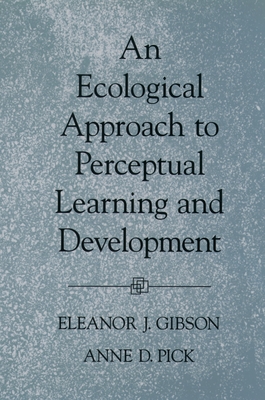An Ecological Approach to Perceptual Learning and Development

An Ecological Approach to Perceptual Learning and Development
In An Ecological Approach to Perceptual Learning and Development, distinguished experimental psychologists Eleanor J. Gibson and Anne D. Pick provide a unique theoretical framework for the ecological approach to understanding perceptual learning and development. Perception, in accordance with James Gibson's views, entails a reciprocal relationship between a person and his or her environment: The environment provides resources and opportunities for the person, and the person gets information from and acts on the environment. The concept of affordance is central to this idea; the person acts on what the environment affords, as it is appropriate.
This extraordinary volume covers the development of perception in detail from birth through toddlerhood, beginning with the development of communication, going on to perceiving and acting on objects, and then to locomotion. It is more than a presentation of facts about perception as it develops. It outlines the ecological approach and shows how it underlies "higher" cognitive processes, such as concept formation, as well as discovery of the basic affordances of the environment. This impressive work should serve as the capstone for Eleanor J. Gibson's distinguished career as a developmental and experimental psychologist.
PRP: 431.90 Lei
Acesta este Prețul Recomandat de Producător. Prețul de vânzare al produsului este afișat mai jos.
345.52Lei
345.52Lei
431.90 LeiIndisponibil
Descrierea produsului
In An Ecological Approach to Perceptual Learning and Development, distinguished experimental psychologists Eleanor J. Gibson and Anne D. Pick provide a unique theoretical framework for the ecological approach to understanding perceptual learning and development. Perception, in accordance with James Gibson's views, entails a reciprocal relationship between a person and his or her environment: The environment provides resources and opportunities for the person, and the person gets information from and acts on the environment. The concept of affordance is central to this idea; the person acts on what the environment affords, as it is appropriate.
This extraordinary volume covers the development of perception in detail from birth through toddlerhood, beginning with the development of communication, going on to perceiving and acting on objects, and then to locomotion. It is more than a presentation of facts about perception as it develops. It outlines the ecological approach and shows how it underlies "higher" cognitive processes, such as concept formation, as well as discovery of the basic affordances of the environment. This impressive work should serve as the capstone for Eleanor J. Gibson's distinguished career as a developmental and experimental psychologist.
Detaliile produsului










